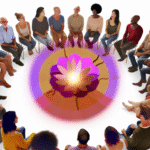
Peaceful Family Dynamics: How to Resolve Conflicts Effectively
Introduction
Family conflict is inevitable. It’s a natural part of human relationships, and even the happiest families face disagreements. However, how we respond to these conflicts can significantly shape the dynamics within our family. In an era where societal pressures and personal stresses are ever-increasing, the skill of resolving conflicts effectively has never been more crucial. That’s where the concept of Peaceful Family Dynamics: How to Resolve Conflicts Effectively comes into play. This article delves deep into practical strategies that families can adopt to cultivate harmony, understanding, and connection amidst disagreements.
Understanding Peaceful Family Dynamics
What Are Family Dynamics?
Family dynamics refer to the patterns of interaction and behavior among family members. They are shaped by various factors, including communication styles, roles within the family, and shared beliefs and values. When these dynamics are healthy and positive, they create an environment conducive to growth, love, and support.
Why Are Peaceful Family Dynamics Important?
Establishing peaceful family dynamics is integral for several reasons:
- Emotional Well-being: Families that communicate openly and resolve conflicts peacefully foster emotional well-being and resilience in their members.
- Role Modeling: Children learn how to handle conflicts from their parents. Demonstrating healthy conflict resolution sets a powerful example for future generations.
- Strengthened Relationships: Effective resolution of conflicts leads to stronger bonds between family members, enhancing overall family unity.
Essential Strategies for Peaceful Conflict Resolution
1. Open Communication
Open communication is the cornerstone of Peaceful Family Dynamics: How to Resolve Conflicts Effectively.
- Active Listening: All parties must listen without interrupting. This shows respect for each other’s viewpoints.
- Expressing Feelings: Encourage family members to express their feelings using “I” statements, which reduce defensiveness. For instance, “I feel hurt when you…” instead of “You always…”
Case Study: The Johnson Family
The Johnson family struggled with communication. Mismatched expectations led to frequent arguments. They implemented regular family meetings where each member could express feelings and concerns. As a result, misunderstandings decreased, reinforcing their connection.
Analysis: This case illustrates how structured communication channels can prevent conflicts and promote understanding.
2. Setting Ground Rules for Conflict
Establishing ground rules during conflicts allows families to navigate disagreements respectfully.
- No Name-Calling: Use respectful language; personal attacks escalate conflicts.
- Stay on Topic: Focus on the issue at hand to avoid venturing into unrelated grievances.
3. Empathy and Understanding
Practicing empathy can transform conflict situations profoundly.
- Walk in Each Other’s Shoes: Encourage family members to see the situation through their loved one’s perspective.
- Ask Questions: Understanding the root of a concern can provide clarity and compassion.
4. Finding Win-Win Solutions
Instead of aiming for victory, strive for solutions that satisfy all parties.
- Brainstorming Together: Involve everyone in developing solutions. This collaborative approach often leads to outcomes that consider everyone’s needs.
- Compromise: Sometimes, a middle ground is necessary. Teaching family members that compromise doesn’t mean losing can foster greater cohesion.
Chart: Conflict Resolution Strategies
Here’s a simple overview of key strategies families can use to resolve conflicts (Table 1):
| Strategy | Description |
|---|---|
| Open Communication | Encourage sharing of thoughts and feelings. |
| Ground Rules | Establish respectful behaviors during conflict. |
| Empathy | Foster understanding by considering others’ feelings. |
| Win-Win Solutions | Collaborate to find solutions beneficial for all. |
Navigating Conflicts in Various Family Structures
Blended Families
Blended families may face unique challenges. Effective conflict resolution in this context often requires:
- Inclusive Communication: Ensure every family member feels included and heard.
- Respect for Individual Differences: Encourage appreciation of varied backgrounds and perspectives.
Case Study: The Smith Family
The Smith family, a blended family, initiated ‘family bonding’ activities to promote connection. When conflicts arose over household responsibilities, they created a shared chore chart through family discussions.
Analysis: This emphasized teamwork and reduced conflict through collaboration.
Single-Parent Families
Single-parent families often bear the weight of additional stress. Strategies may include:
- Seeking Outside Support: Encouraging community connections can provide the emotional support needed.
- Routine Establishment: Stable routines can minimize chaos and reduce conflict.
Fostering Long-Term Peaceful Family Dynamics
1. Regular Check-Ins
Scheduling regular family check-ins can provide a platform for discussing any accumulating issues before they escalate.
- Family Meetings: Use these to manage grievances and celebrate achievements.
- One-on-One Time: Encourage individual connections to deepen understanding among members.
2. Promote Emotional Intelligence
Teaching family members about emotional intelligence can significantly improve interactions.
- Identifying Emotions: Encourage recognizing one’s own emotions and those of others.
- Regulating Responses: Develop strategies to manage emotional responses effectively.
3. Use of Conflict Resolution Tools
Incorporating certain tools can make the process smoother:
- Using “Feelings Charts”: These visual aids help younger family members express their emotions more clearly.
- Conflict Resolution Worksheets: These can guide structured discussions during conflicts.
Conclusion
Peaceful Family Dynamics: How to Resolve Conflicts Effectively is a multifaceted journey that requires commitment, patience, and a willingness to grow together as a family. By employing strategies like open communication, empathy, and collaborative problem-solving, families can create an environment where conflicts are not feared but seen as opportunities for growth.
To foster lasting peaceful dynamics, it’s essential to regularly check in with one another, build emotional intelligence, and actively work towards inclusive solutions. Remember, conflict doesn’t have to disrupt family harmony; instead, it can strengthen the bonds we cherish most.
FAQs
1. What should I do when conflicts become too heated?
When conflicts escalate, take a break. Allow everyone time to cool off before returning to the discussion calmly.
2. How can I teach my children to resolve conflicts with their peers?
Model conflict resolution at home. Teach them active listening, the importance of empathy, and guide them to find win-win solutions.
3. Is it okay to seek outside help for family conflicts?
Absolutely! Professional therapy or counseling can provide invaluable tools and strategies for navigating complex family dynamics.
4. How can we ensure everyone feels heard during conflicts?
Establish a “talking stick” rule where only the person holding a designated item can speak during discussions, ensuring everyone has a chance to express themselves.
5. Can positive reinforcement help in promoting peaceful conflict resolution?
Yes! Recognizing and praising effective conflict resolution behaviors in family members reinforces those practices and encourages their continuation.
Embarking on the journey toward Peaceful Family Dynamics: How to Resolve Conflicts Effectively is not only worthwhile but transformative, leading the way to deeper connections, understanding, and harmony within your family.















